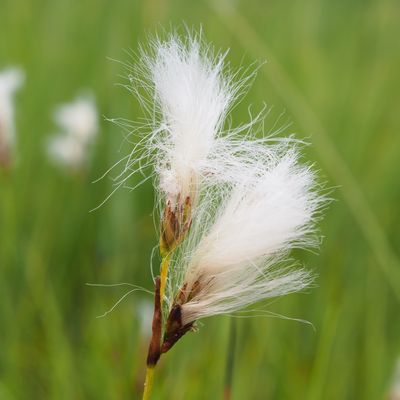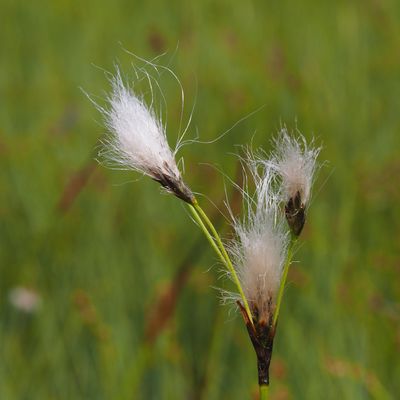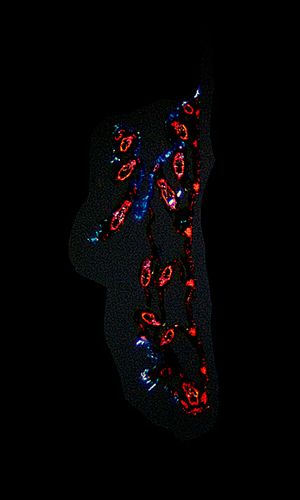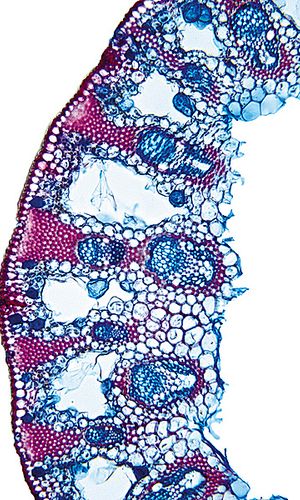Eriophorum gracile Roth
1017650
Species
ISFS : 155300
Checklist : 1017650
ISFS : 155300
Checklist : 1017650
Contains :
Synthesis
Species description (© Flora Helvetica 2018)
Stängel 20-50 cm hoch, stumpf 3kantig, mit Ausläufern. Blätter meist vom Grund an schmal rinnig-3kantig, Ähren nur 3-5, ihre Stiele filzig-rau, Tragblätter mit mehreren Nerven. Sonst wie E. latifolium (Nr. 2651).Flowering period (© Flora Helvetica 2018)
5Habitat and distribution inside Switzerland (© Flora Helvetica 2018)
Flachmoore / kollin-montan(-subalpin) / M, A, sehr zerstreutWorld distribution (© Flora Helvetica 2018)
Eurosibirisch-nordamerikanischEcological indicator (© Landolt & al. 2010)
4+w22-43+3.g.2n=76Status
IUCN status
EndangeredNational Priority
3 - medium national priorityInternational responsibility
1 - weakConservation
Threats
Lebensraumzerstörung, Meliorationen, Eingriffe in den Wasserhaushalt
Bau von Verkehrsanlagen, Industriebauten, Golfplätzen und Siedlungen
Eutrophierung
Verbuschung, Nutzungsaufgabe, natürliche Moorsukzession
Lokale Nährstoffkatastrophen (Überflutung mit eutrophem Wasser)
Mechanische Einwirkungen durch Freizeitaktivitäten (z. B.Tritt, Photographieren)
Kleine, isolierte Populationen
Anatomy
Summary of leaf anatomy (German)
Obere Epidermiszellen grösser als untere. Punktuelle Versteifungselemente am Blattrand und bei der Blattrippe. Verbindungs-Steg zwischen oberer und unterer Epidermis homogen verholzt. Leitbündel im Verbindungs-Steg unten eingebettet. Leitbündelhülle verholzt.Summary of stem anatomy (German)
Umriss rund oder oval. Leitbündel in mehreren Reihen. Konische Stützen. Grosse, unregelmässige Intercellularen. Epidermiszellen aussen verholzt.Description
Culm-diameter 1-2 mm, wall very large, radius of culm in relation to wall thickness approximately 1: 0.75. Culm-center hollow and surrounded by many large thin-walled, not lignified cells. Epidermis cells inside thin, peripheral thicker-walled (lignified). Guard cells with externally acute ledge. Large vascular bundles arranged in 2-3 peripheral rows. Chlorenchyma absent. Sclerenchyma belt absent. Groups of sclerenchyma square or rectangular. Vascular bundles collateral closed. Small sclerenchymatic sheath around vascular bundles with 1-2 cells. Largest vessel in the bundle small, < 20μm. Cavities (intercellulars) between parenchyma cells absent. Distinct cavities (intercellulars) in the protoxylem area of vascular bundles. Cell contents as slime or phenols in isolated cells.Distribution map
Habitat and distribution inside Switzerland
M, A, sehr zerstreutWorld distribution
Eurosibirisch-nordamerikanischEcology
Life form
Geophyte
Habitats
Milieux Phytosuisse (© Prunier et al. 2017)
Habitats © Delarze & al. 2015
 | 2.2.4 - Übergangsmoor (Caricion lasiocarpae) |
bold
Dominant species, influencing the appearance of the habitat
 Character species
Character species
 Less strictly linked to a specific habitat
Less strictly linked to a specific habitat
Ecological indicator values by © Landolt & al. (2010)
| Soil factors | Climatic factors | Salinity tolerance | |||
|---|---|---|---|---|---|
| Humidity Value H | 4+w | Light Value L | 4 | Salinity Index | -- |
| Reaction Value R | 2 | Temperature factor T | 3+ | ||
| Nutriments value N | 2 | Continentality K | 3 | ||
- Ecological values legend
Humidity Value H 1 very dry 1+ dry 2 moderatly dry 2+ moist 3 medium wet 3+ wet 4 very wet 4+ soggy 5 submerged or underwater f plants living in running water u mostly submerged plants v partly submerged, partly floating plants w humidity moderately variable (± scale of 1-2) w+ highly variable humidity (scale exceeding ± 2) Reaction Value R 1 Very acid (pH 2.5-5.5) 2 acid (pH 3.5-6.5) 3 lightly acid to neutral (pH 4.5-7.5) 4 neutral to basic (pH 5.5-8.5) 5 basic (pH 6-5 -> 8.5 Nutriments value N 1 very low in nutrients 2 low in nutriments 3 medium-poor to medium-rich in nutrients 4 rich in nutriments 5 very rich in nutriments Salinity tolerance 1 halotolerant 3 halophyle Light Value L 1 very shady 2 shady 3 lighted areas 4 luminous 5 highly luminous Temperature factor T 1 alpine to nival stages (from the treeline to the snowline) 1+ suprasubalpine and upper subalpine levels (pine and larch forests) 2 subalpine level (coniferous forests without beeches up to the upper limit of spruces) 2+ lower subalpine and upper mountain stages 3 mountain level (beech and silver fir forests, in the central Alps Scots pine forests) 3+ lower mountain and upper hill levels 4 hill level (mixed deciduous oak forests) 4+ hot places, hill level 5 very hot places, hill level (only in the hottest places, typical of southern Europe) Continentality K 1 Atlantic (high air humidity, very low temperature variations, mild winters) 2 Sub-Atlantic (high air humidity, low temperature variations, relatively mild winters) 3 sub-Atlantic to subcontinental (average air humidity, moderately variable temperature, slightly low winter temperatures) 4 subcontinental (low air humidity, large temperature variations, rather cold winters) 5 continental (very low air humidity, very large temperature variations, cold winters)
Water dependency
| Rivers | 1 - Secondary habitat |
| Calm water | 1 - Secondary habitat |
| Ground water | 0 - No link |
Nomenclature
Accepted Name (Checklist 2017)
Eriophorum gracile Roth
Vernacular name
Deutscher Name :
Zierliches WollgrasNom français :
Linaigrette grêleNome italiano :
Pennacchi graciliMatch with other reference books
| Relation | Nom | Book | No |
|---|---|---|---|
| = | Eriophorum gracile Roth | Checklist 2017 | 155300 |
| = | Eriophorum gracile Roth | Flora Helvetica 2001 | 2477 |
| = | Eriophorum gracile Roth | Flora Helvetica 2012 | 2653 |
| = | Eriophorum gracile Roth | Flora Helvetica 2018 | 2653 |
| = | Eriophorum gracile Roth | Index synonymique 1996 | 155300 |
| = | Eriophorum gracile Roth | Landolt 1977 | 433 |
| = | Eriophorum gracile Roth | Landolt 1991 | 381 |
| = | Eriophorum gracile Roth | SISF/ISFS 2 | 155300 |
| = | Eriophorum gracile Roth | Welten & Sutter 1982 | 2399 |
= The taxon corresponds to the accepted taxon (Checklist 2017)
< The taxon is included in the accepted taxon (Checklist 2017)
> The taxon includes (among others) also the accepted taxon (Checklist 2017)
< The taxon is included in the accepted taxon (Checklist 2017)
> The taxon includes (among others) also the accepted taxon (Checklist 2017)
Status
Native status
-IUCN list of endangered species (© Walter & Gillett 1997) : No
Status on national Red List 2016
IUCN status:
Endangered

Additional information
IUCN criteria: B2ab(iii)
Status on regional Red List 2019
| Biogregraphic regions | Status | IUCN criteria |
|---|---|---|
| Jura (JU) | RE | |
| Mittelland (MP) | EN | B2ab(iii) |
| Alpennordflanke (NA) | EN | B2ab(iii) |
| Alpensüdflanke (SA) | CR(PE) | |
| Östliche Zentralalpen (EA) | CR(PE) | |
| Westliche Zentralalpen (WA) | RE |
- Legend
EX Extinct RE Regionally Extinct CR(PE) Critically Endangered, Probably Extinct CR Critically Endangered EN Endangered VU Vulnerable NT Near Threatened LC Least Concern DD Data Deficient NE Not Evaluated NA Not Applicable
National Priority Species List Status
| National Priority | 3 - medium national priority |
| Need to take action | 2 - |
| International responsibility | 1 - weak |
| Need to monitor populations | 2 - |
Protection status
| International (Bern Convention) | No | |
| AG | total protection | (01.01.2010) |
| BE | total protection | (01.01.2016) |
| GR | total protection | (01.12.2012) |
| SH | total protection | (06.03.1979) |
| Switzerland | total protection | |
| TG | total protection | (01.01.2018) |
| VD | total protection | (02.03.2005) |
| ZG | total protection | (01.10.2013) |
| ZH | partial protection | (03.12.1964) |
- Disclaimer
InfoFlora compiles information on protected species as accurately as possible, taking it from the respective cantonal laws. In some cases, however, it was not possible to use the plant names as listed in the original text, but an interpretation of their taxonomy or nomenclature was necessary. The exact meaning of the categories „completely protected“ and „partially protected“ differs among the cantons.
InfoFlora cannot guarantee that the information on the protection status is correct and complete. In case of doubts, we recommend to look up the texts of the respective cantonal law.
Status by sector of activity
| Agriculture-related environmental objectives : | more informations | |
| Forest management environmental objectives : | more informations |
Conservation
Threats and measures
Lebensraumzerstörung, Meliorationen, Eingriffe in den Wasserhaushalt
Vermeidung einer stärkeren Änderung des Wasserhaushaltes, falls nötig Regulierung des Wasserstandes (durch Unterhalt und Regulierung der bestehenden Rietgräben)
je nach Gebiet auch Wiedervernässung prüfen
Bau von Verkehrsanlagen, Industriebauten, Golfplätzen und Siedlungen
Vorrang der wertvollen Lebensräume vor Bauprojekten
Eutrophierung
Düngungsverbot auch in der Umgebung
Ausscheidung vongrossen Pufferzonen
Verbuschung, Nutzungsaufgabe, natürliche Moorsukzession
Entbuschen
ausholzen
Streuenutzung weiterführen
Bewirtschaftungsverträge abschliessen.
Selektives Entfernen der Gehölze samt Wurzelwerk mit Kleinbaggern unter Schonung der Begleitvegetation
Lokale Nährstoffkatastrophen (Überflutung mit eutrophem Wasser)
Massnahmen zur weiteren Nährstoffreduktion in den benachbarten Gewässern durchführen
Mechanische Einwirkungen durch Freizeitaktivitäten (z. B.Tritt, Photographieren)
Besucherlenkung in Problembereichen
Wege sperren oder durch «Knüppelpfade» ersetzen
Kleine, isolierte Populationen
Schutz (Mikroreservate)
regelmässige Bestandeskontrollen aller Populationen
populationsbiologische Untersuchungen und Dauerflächen-Beobachtung
durch Wiedervernässung an geeigneten Stellen potentielle Lebensräume schaffen
für vollständigen Schutz vorgeschlagen
Erfolgskontrolle der Massnahmen gewährleisten, Verstärkung von bestehenden Populationen und Ansiedlung von neuen Populationen durch Anpflanzung (nach Zwischenvermehrung)






